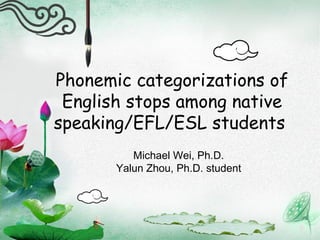
Phonemic categorizations of English stops among native speaking/EFL/ESL students
- 1. Phonemic categorizations of English stops among native speaking/EFL/ESL students Michael Wei, Ph.D. Yalun Zhou, Ph.D. student
- 2. Introduction 3. However, there is an absence of voiceless/voiced contrasts among stops after word-initial /s/ 1. voiceless /p, t, k/ and voiced /b, d, g/. English stops 2. In most cases, these two types of stops contrast with each other. 4. phonetically or acoustically, English stops after word initial /s/ are more similar to /b, d, g/ similarity 5. the English writing system represents stops after initial /s/ as voiceless P, T, C/K (e.g. sPort, sTop, sChool, sKate etc.). complicated Contrast absence
- 3. Introduction Complexity about review These phonetic and orthographic complexities of English stops after /s/ as well as people’s different perceptions toward them have drawn linguists’ attention on how people categorize these phonemes and have resulted in long-standing disputes (Jaeger, 1980). We limit our review on phonetic and phonemic perceptions of people with different ages and different native languages (for more theoretical review, see Mompeán-González, 2004).
- 4. Literature review Davidson-Nielsen (1969) Davidson-Nielsen (1969) Lotz el al. (1960) Lotz el al. (1960) No differences between British English speakers and American English speakers in telling differences between voiceless and voiced stops. Both British and American native English-speaking participants perceived the words such as spear, steam, score to begin with B, D, G. The first (maybe the only) one that involves both native and nonnative English-speaking participants. native speakers of American English identified the residual stops (i.e. the stops after /s/) as voiced /b, d, g/ after the initial /s/ was cut off in the recording; the others, native speakers of Spanish, Hungarian, and Thai, identified them as voiceless stops.
- 5. Jaeger (1980) Jaeger (1980) Ehri and Wilce (1980) Lotz el al. (1960) Literature review They concluded that the differences were due to the distinctions of the languages in phonemic system. 25 out of 27 (92.6%) of participants psychologically perceived phoneme /k/ in [sk] cluster as the syllable-initial aspirated [kh]-words such as kind, candle, chlorine . This perception is in line with the notion that phonemes as a unit are important functions in “speech perception ” (p.250), and this is especially true in an alphabetic writing system. Their research indicated that the knowledge of word spellings influences fourth grade native English-speaking children’s perception of the phonemic segments in words (regardless of the familiarity of the words).
- 6. Literature review Ehri and Wilce (1980) Wei& Zhou’s Wei& Zhou’s Wei & Zhou’s Children’s perception of the phoneme segments derived from the visual forms gained in their reading experiences. Most studies are decades old and focus on native English speakers’ perceptions on individual phonemes under forced situation (i.e. participants react to the cut recordings). Very few studies on nonnative English speakers’ phonemic categorization in perceiving the residual stop segments after word-initial/s/ as a unit. None has ever studied the nonnative English speakers whose language system is non-alphabetic (e.g. Chinese) in writing system and is lack of /s/ plus stop clusters in phoneme system. Even fewer is the study on bilinguals’ phoneme categorization.
- 7. Wei & Zhou’s Wei & Zhou’s Literature review This research intended to fill this gap of literature by studying the relative perceptions of monolingual Chinese children, monolingual English children and bilingual Chinese-English children . In a phoneme deletion task, these three groups of children were asked to tell their phonemic categorizations of the residual stop segments after the removal of word-initial /s/.
- 8. Purposes of this study Wei & Zhou residual stop segments after word-initial /s/ Monolingual Chinese/English speaking children Bilingual English-Chinese speaking children The results would provide updated information on the study of English stops after word-initial /s/, verify previous studies, and provoke further investigations in second language acquisition and second language literacy. compare phonemic categorizations with different linguistic backgrounds
- 10. Method
- 11. Method Test items Nonsense words The test items contained both real and nonsense words. Practice items All the practice items were real words and did not contain English stops after word-initial/s/. Some real words after removing /s/. /sku:l/ - /ku:l/ or /gu:l/. Children need to decide what sound was left in the segment.
- 16. Results (All three groups)
- 17. Conclusion monolingual Chinese-speaking children and monolingual English-speaking children had sharp differences on segments after word-initial /s/ bilingual Chinese-English children were between with more tendencies to that of monolingual English-speaking children. monolingual Chinese-speaking and bilingual Chinese-English-speaking had different phonemic categorization.
- 18. Conclusion once children internalize the orthographic conventions of English stops after word-initial /s/, they never hear /b, d, g/ after /s/ again The different perceptions of children with different literacy history are with the length of formal literacy instruction and the knowledge of orthography are crucial in phonemic judgments.
- 19. How should English teachers teach the English stops after word-initial /s/? 1 Thank You! 2 challenges to SL A Conclusion What is the pacing and timing to teach the acoustic ambiguity and orthographic processing complexities of the /s/ + stop clusters?